The Effect of Crop Adjustment and Desiccation Spray on Ripeness (2016)
Matthieu Finot
King Family Vineyards
Summary
This study examines the impact of different crop adjustment techniques on yield, juice and wine chemistry, phenolic and color profiles, and sensory characteristics of Merlot. The four treatments in this trial were performed in the same vineyard block as follows: two control rows, two rows sprayed with RG 1950 desiccant spray 4 times over 4 weeks beginning at veraison, two rows with clusters dropped at veraison down to one cluster per shoot, and two rows with clusters pinched at approximately 20 Brix. All other treatments, through vinification, were the same. The desiccation spray exhibited faster ripening kinetics and lower average berry weight. At harvest, Brix and pH were not very different, but TA was higher in the treatments. No differences were apparent in wine chemistry. All treatments exhibited increases in color intensity, especially the cluster dropped treatment. In spite of increasing color intensity all treatments lowered anthocyanins. The desiccant treatment slightly increased tannins. The week before harvest, 6 inches of rain fell, which may have reduced the impact of these treatments. Overall, desiccation and crop reduction had a slight tendency to enhance Fruit Intensity. The treatments also tended to enhance Overall Aromatic Intensity. These trends were weak and often conflicted between tastings. There seemed to be a general preference for wines produced from dropped clusters and desiccated clusters, but this varied. The rain event may have reduced the impact of these treatments. This study suggests that crop adjustment techniques have the potential to impact fruit and wine quality in Virginia, but much more studies are needed to fully quantify this impact as well as to account for vintage variation.
Introduction
In regions with common rainfall, ripening problems may occur due both to dilution from rain as well as from forced early harvest to avoid excessive disease pressure. As such, crop management techniques provide a key tool to enhance ripening kinetics and reduce disease pressure. One such method for crop management involves crop desiccation. Desiccation naturally concentrates several ripeness factors in grape berries. Crop desiccation occurs naturally in regions with low rainfall, but is generally impeded by rain. A potassium bicarbonate desiccant spray (RG 1950) has been developed which can instigate desiccation in grape berries.
Another common technique which attempts to improve grape quality is crop thinning. This practices reduces yield and increases the leaf area:yield ratio, which is thought to enhance photosynthate accumulation in the berries. Although some have found positive effects from cluster thinning such as increased Brix, increased and mature phenols, flavonoid phenols, and glycosides (Zoecklein 2000; Zoecklein 2002; Guidoni et al. 2002; Bubola et al. 2011; Gatti et al. 2012; Avizcuri-Inac et al. 2013; Bubola et al. 2017), others have found little effect (Keller et al. 2005; Nuzzo and Matthews 2006; Bubola et al. 2017). These results seem to depend on finding an optimal leaf area: crop ratio, which will vary among regions and between vintages. In Virginia, the recommended crop load is 1-2 pounds of fruit per foot of wire (2.5-5 tons per acre on VSP on 9’ x 5’ rows). Higher yields are more appropriate for warmer, dryer seasons, and in general white wine grapes can handle higher yields better than red wine grapes (Wolf 2012; Hatch 2015). This study examines the impact of cluster dropping, desiccation spray, and cluster pinching on the chemical and sensory qualities of Merlot.
Results and Discussion
The desiccation spray exhibited faster ripening kinetics and lower average berry weight. At harvest, Brix and pH were not very different, but TA was higher in the treatments. No differences were apparent in wine chemistry. All treatments exhibited increases in color intensity, especially the cluster dropped treatment. In spite of increasing color intensity all treatments lowered anthocyanins. The desiccant treatment slightly increased tannins. The week before harvest, 6 inches of rain fell, which may have reduced the impact of these treatments (as can be seen by increasing berry weight in the desiccated treatment).

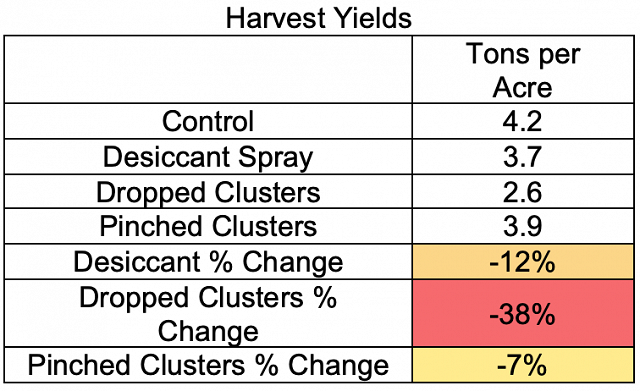
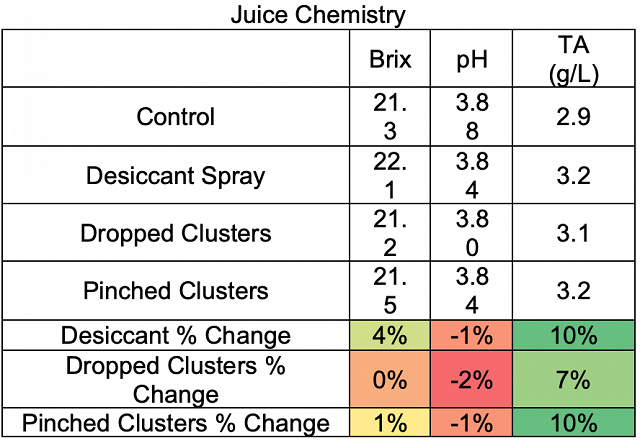

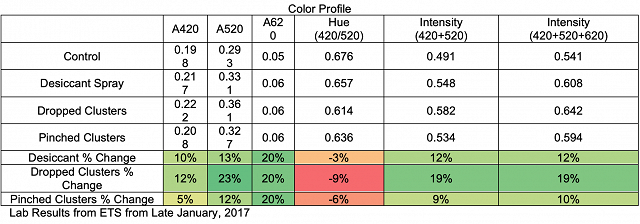


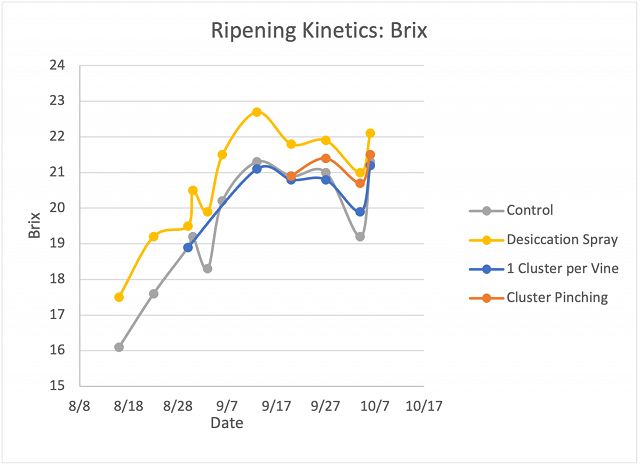
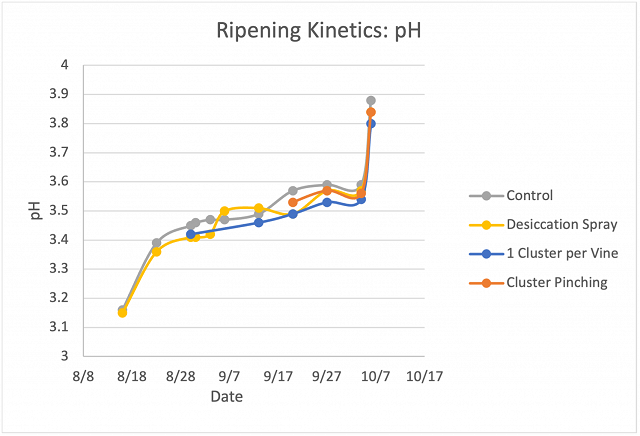
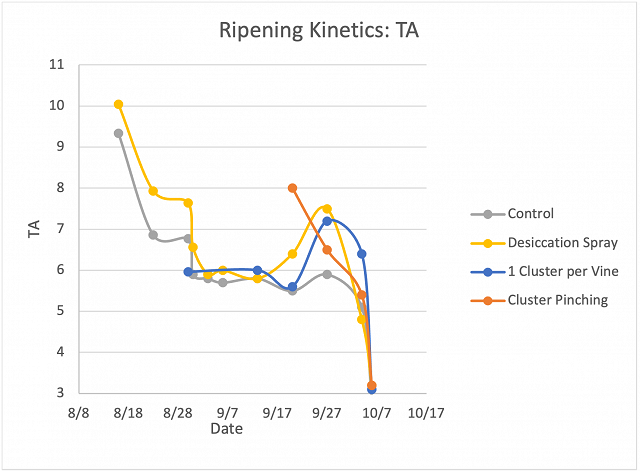
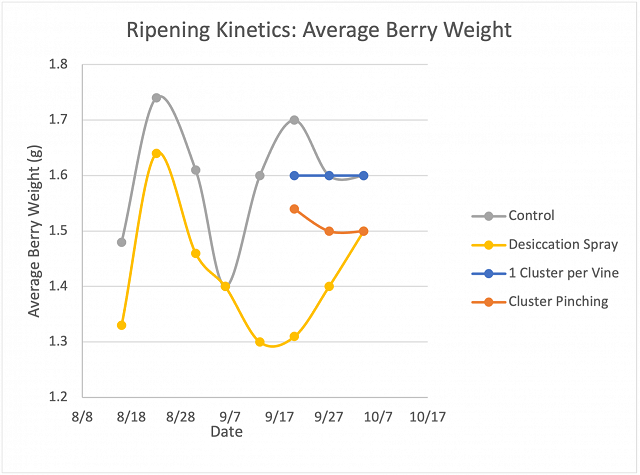
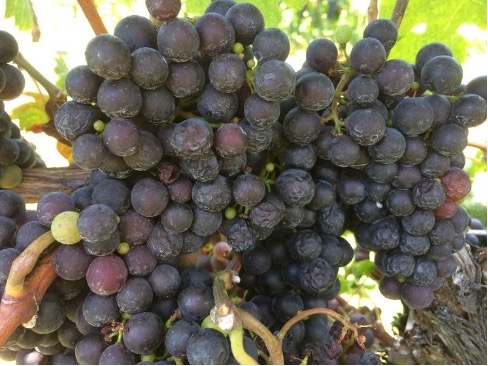
Dessicated Cluster
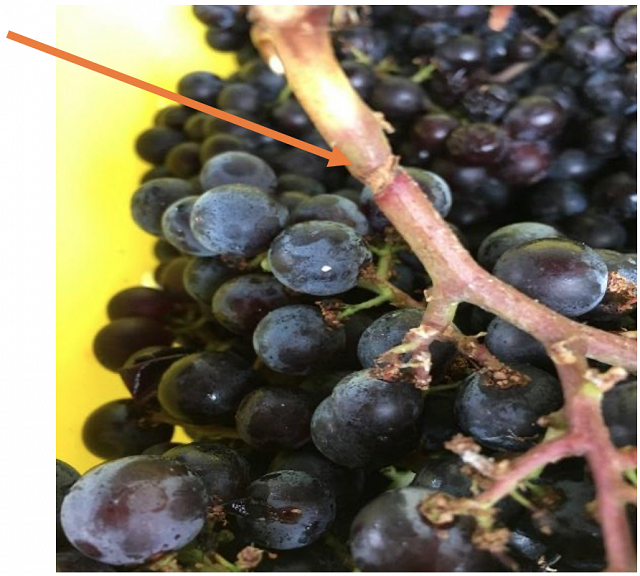
Pinched Cluster
Descriptive analysis did not find any strong trends with the descriptors used for the April 12 tasting. Pinched clusters seemed to have slightly reduced Herbaceous/Green character, and also have higher body along with desiccated clusters. Additionally, some judges described the wines as having some diacetyl or malolactic character. In general, judges tended to prefer wine made from the desiccated clusters followed by the control.
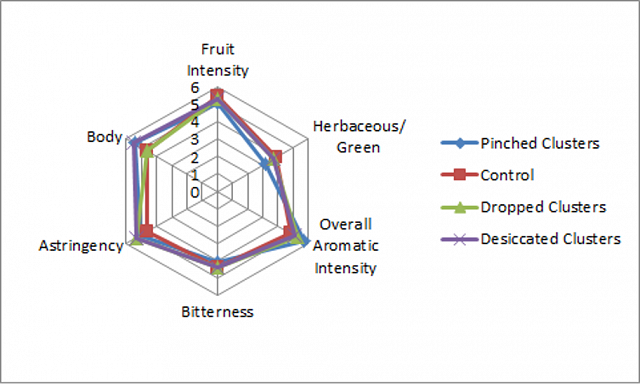

Descriptive analysis on May 3 showed no strong trends between treatments for the descriptors used in this study. However, Desiccated and Dropped cluster treatments tended to show higher Fruit Intensity, and Desiccation tended to result in higher Overall Aromatic Intensity. Pinched clusters tended to result in higher scores for Herbaceous/Green and lower scores for Body. Dropped Clusters also tended to lower Bitterness. For the May 3 tasting, in general judges preferred the Desiccated Clusters, followed by the Dropped Clusters.
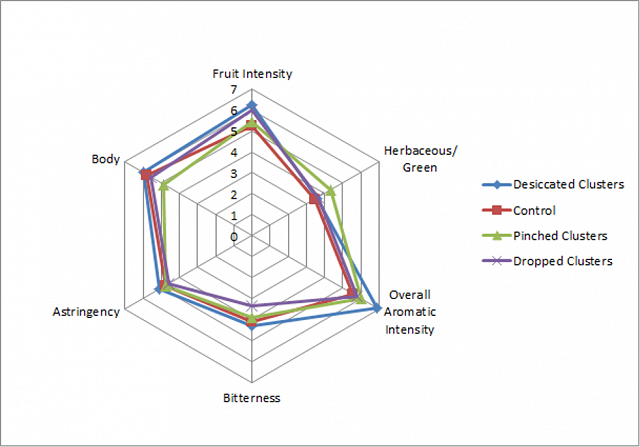

Descriptive analysis for the May 31 tasting did not show any strong trends for the descriptors used in this study. There was a slight tendency for desiccation to increase Fruit Intensity, and cluster pinching to increase Astringency. All of the treatments slightly increased Herbaceous/Green character and Overall Aromatic Intensity relative to the control. All of these trends were weak, however. In general, judges most preferred dropped clusters, followed by the control. Pinched clusters were least preferred. The preference trends were weak, however.
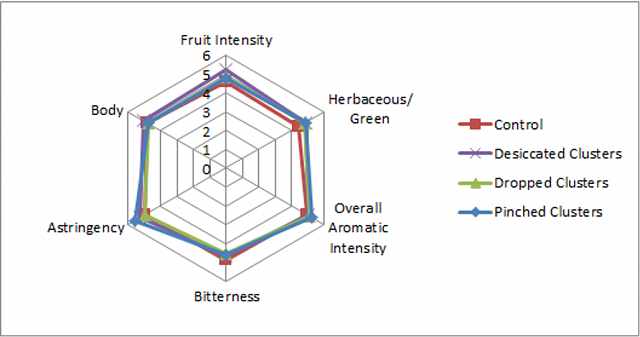

Overall, desiccation and crop reduction had a slight tendency to enhance Fruit Intensity. The treatments also tended to enhance Overall Aromatic Intensity. These trends were weak and often conflicted between tastings. There seemed to be a general preference for wines produced from dropped clusters and desiccated clusters, but this varied. The rain event may have reduced the impact of these treatments. This study suggests that crop adjustment techniques have the potential to impact fruit and wine quality in Virginia, but much more studies are needed to fully quantify this impact as well as to account for vintage variation.
Methods
In a block of Merlot 8 rows were treated as follows:
- 2 rows (0.31 acre) will be used as control (MRLA3C)
- 2 rows (0.31 acre) will be sprayed with RG 1950 (potassium bicarbonate) in collaboration with VA tech (MRLA3T2)
- 2 rows (0.31 acre) will have every stem pinched (MRLA3T3)
- 2 rows (0.31 acre) will have clusters dropped so there is only one cluster per vine at veraison (MRLA3T1)
RG 1950 Desiccation Spray:
The desiccant was sprayed 4 times beginning at veraison and then weekly for a total of 4 sprays over 4 weeks. The dates of the spray was on August 9 at 864.5g/acre, and thevineyard was sprayed once a week for three more weeks at 648g/acre. The spray was done with backpack sprayer only on the fruit zone.
Stem pinching:
Pinching occurred on September 15th, where each individual merlot clusters will have the stem pinched to reduce the sap flow and start a natural dehydration on the vine.
Crop reduction:
Performed the week of August 9th (approximately ⅔ veraison), only one cluster per shoot was left on the vines (40% crop reduction)
The preceding weeks before harvest (9/25- 10/2) there were 6 inches of rain:
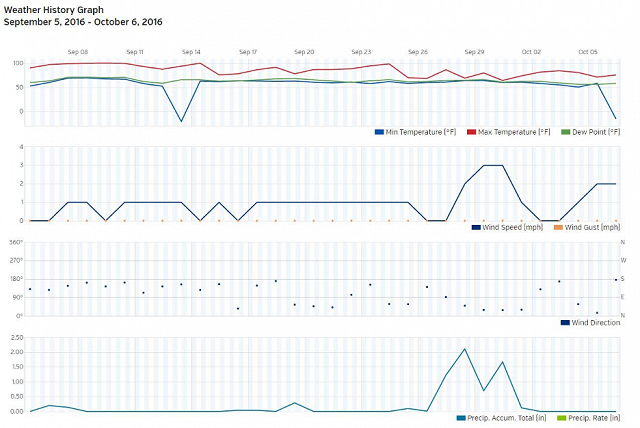
The Merlot treatments were harvested on 10/5/2016 and destemmed and crushed on 10/6 into 4 T-Bins for each treatment. Each treatment received 3g/hL sulfur dioxide during crush along with 0.25kg/ton mini chips bois frais. All three treatments were inoculated with Fermol Premier Cru. On 10/9, 1g/L tartaric acid and 0.22 g/L malic acid was added to each treatment. On 10/10, 6g/hL Lafase HE Grand Cru was added to each treatment. On 10/11 17g/hL Fermaid K was added. On 10/13, 22g/L sugar was added to each treatment.
All treatments were pressed on 10/24 to ensure equal maceration times between treatments. These were then racked off lees into identical neutral barrel on the same day. On 11/16 the wines were stabilized with sulfur dioxide.
This project was tasted on April 12, May 3, and May 31. In order to balance the data set to perform statistical analysis for descriptive analysis on the April 12 tasting, any judge who had not fully completed the descriptive analysis ratings were removed. This resulted in a final data set of 3 groups, each with 5 judges (considered as replications within groups, and groups were considered as assessors). Data was analyzed using Panel Check V1.4.2. Because this is not a truly statistical set-up, any results which are found to be statistically significant (p<0.05) will be denoted as a “strong trend” or a “strong tendency,” as opposed to general trends or tendencies. The statistical significance here will ignore any other significant effects or interactions which may confound the results (such as a statistically significant interaction of Judge x Wine confounding a significant result from Wine alone). The descriptors used in this study were Fruit Intensity, Herbaceous/Green, Overall Aromatic Intensity, Bitterness, Astringency, and Body.
The same procedures for data analysis were used on the May 3 tasting. For the descriptive analysis in this tasting, one judge was eliminated from group 3 so that each group had 3 judges, for a total of 9 judges.
The same procedures for data analysis were used on the May 31 tasting. For the descriptive analysis in this tasting, one judge was eliminated from group one so that each group had four judges, for a total of 12 judges.
References
Avizcuri-Inac, J.M., Gonzalo-Diago, A., Sanz-Asensio, J., Martínez-Soria, M.T., López-Alonso, M., Dizy-Soto, M., Echávarri-Granado, J.F., Vaquero-Fernández, L., and Fernández-Zurbano, P. 2013. Effect of cluster thinning and prohexadione calcium applications on phenolic composition and sensory properties of red wines. J. Agric. Food Chem. 61:1124-1137.
Bubola, M., Paolo Sivilotti, P., Janjanin, D., and Poni, S. 2017. Early leaf removal has larger effect than cluster thinning on cv. Teran grape phenolic composition. Am. J. Enol. Vitic. In Press.
Bubola, M., Peršurić, D. and Kovačević Ganić, K. 2011. Impact of cluster thinning on productive characteristics and wine phenolic composition of cv. Merlot. J. Food Agric. Environ. 9:36-39.
Gatti, M., Bernizzoni, F., Civardi, S., and Poni, S. 2012. Effects of cluster thinning and preflowering leaf removal on growth and grape composition in cv. Sangiovese. Am. J. Enol. Vitic. 63:325-332.
Guidoni, S., Allara, P., and Schubert, A. 2002. Effect of cluster thinning on berry skin anthocyanin composition of Vitis vinifera cv. Nebbiolo. Am. J. Enol. Vitic. 53:224-226.
Hatch, T. 2015. What’s your crop load? Viticulture Notes: Vol 3. Virginia Cooperative Extension. http://arec.vaes.vt.edu/content/dam/arec_vaes_vt_edu/alson-h-smith/grapes/viticulture/extension/news/vit-notes-2015/vit_notes_april_2015.pdf
Keller, M., Mills, L.J., Wample, R.L., and Spayd, S.E. 2005. Cluster thinning effects on three deficit-irrigated Vitis vinifera cultivars. Am. J. Enol. Vitic. 56:91-103
Nuzzo, V. and Matthews, M.A. 2006. Response of fruit growth and ripening to crop level in dry-farmed Cabernet Sauvignon on four rootstocks. Am. J. Enol. Vitic. 57:314-324.
Wolf, T. 2012. Vineyard management reminders. Viticulture Notes 27(2). Virginia Cooperative Extension. http://arec.vaes.vt.edu/content/dam/arec_vaes_vt_edu/alson-h-smith/grapes/viticulture/extension/news/vit-notes-2012/vitnotes-may-2012.pdf.
Zoecklein, B. 2000. VVA meeting presentation 2000. http://www.apps.fst.vt.edu/extension/enology/extonline/VVA2000.html.
Zoecklein, B. 2002. Red wine phenolic management, continued. Enology Notes #62. http://www.apps.fst.vt.edu/extension/enology/EN/62.html.
